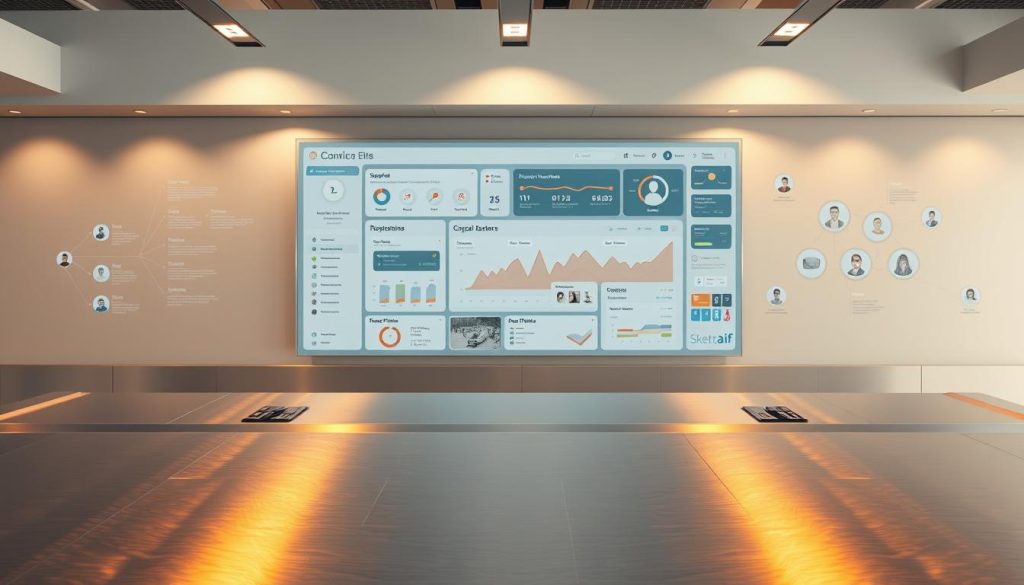Can we keep the focus of handwriting and gain the speed of software without extra friction?
We often start ideas on paper because writing by hand improves recall and focus. Then we move notes into platforms like ClickUp, Trello, Asana, Todoist, Notion, and Roam for collaboration, deadlines, and search.
Our hybrid approach uses a simple cycle: capture on paper, organize in a central system, and prioritize with a short analog review. This keeps structure strong and attention high.
When we add OCR, meeting transcription, and AI-assisted action items, we remove bottlenecks, reduce human error, and speed up delivery. The result is fewer delays and a smoother user experience for teams and clients.
In this article, we show which productivity tools to keep, which to cut, and the practical steps that make sure your notes flow into a single source of truth every day.
Key Takeaways
- Handwritten capture boosts focus and memory, then move clear items into a central system.
- A practical hybrid approach prevents scattered notes and duplicate effort.
- Use OCR and meeting transcription to turn paper and speech into searchable records.
- Keep your stack lean: choose the few productivity tools that actually solve problems.
- Expect fewer bottlenecks, fewer errors, and a better experience for your team.
Why a Hybrid Approach Wins Today: From Pen and Paper to Productive Digital Workflows
Putting ideas on paper first gives our brain space to process and make connections.
Handwriting for recall, focus, and deeper engagement
Handwriting helps memory and clarity
Writing hand notes activates cognitive paths that improve recall. Short sketches and bullets let us iterate ideas quickly without screen glare.
Digital strengths: collaboration, search, automation, and scalability
Platforms such as ClickUp, Asana, and Trello centralize information, enable version control, and automate reminders. A clear source of truth gives ownership and consistent management.
The sweet spot: minimizing distractions while maximizing structure
We keep paper for brainstorms and daily focus, then move actionable items into a single system. This balance preserves creative flow and lets teams scale work with fewer errors.
- Why it works: pen paper first, then centralized execution.
- Where analog tools shine: mapping, freeform thinking, rapid capture.
- Where digital tools win: searchable archives, commenting, automated follow‑ups.
Build Your Hybrid System: A Step-by-Step Workflow You Can Use Right Now
Begin with a short inventory of repeated steps and slow handoffs in your day.
We start by shortlisting high-impact candidates for digitization. Pick processes with high volume, high risk, or high time cost. Then run a quick audit to map tasks, spot bottlenecks, and rank what to convert first.
Audit and prioritize
How we score candidates: volume × risk × minutes saved. Focus on tasks that return the most time.
- Map the end-to-end process and note manual handoffs.
- Identify repetitive task steps and delays in approvals.
- Score each item and pick the top three to digitize first.
Set a single source of truth
Choose one system for records and archives. Limit overlapping apps and make sure permissions and roles are clear. This reduces duplication and helps teams find work fast.
Daily cycle and digitization
Adopt a morning paper brainstorm, mid-morning digital triage, and an afternoon paper reprioritization. Use OCR to convert notes into searchable PDFs and back them up automatically.
| Phase | Action | Key Metric |
|---|---|---|
| Audit | Map tasks, shortlist candidates | Processing time (mins) |
| Digitize | OCR PDFs, integrate calendar & comms | Completion rate (%) |
| Operate | One system of record, roles set | Errors / month |
Get started with a lightweight intake template and weekly review cadence. Document full SOPs only for high-risk processes; use checklists for fast, low-risk tasks. Over time, trim apps so the system stays fast and useful.
Plan and Schedule with Confidence: Calendars, Weekly Reviews, and Time Blocks
Effective weekly planning keeps commitments visible and protects blocks for deep work.
We rely on a synced calendar for complex schedules because it updates instantly, sends reminders, and connects with your task manager. That live visibility beats keeping everything in a paper planner when meetings shift or travel changes.
Why calendars outperform paper for complex scheduling
Instant updates and shared visibility prevent double bookings. Automated reminders reduce missed commitments and ease calendar management.
Integrations link events with tasks and information so context is a click away. Rescheduling stays painless because events propagate across apps and devices.
Weekly planning flow: reflect, align, and block
Start with a short pen paper reflection: note wins, pain points, and top priorities for the week.
Next, align those priorities into your calendar using digital tools. Add meetings, deadlines, and buffers for transitions.
Finally, create protected time blocks for deep work, admin, and collaboration. Use recurring events for routines and leave recovery slots after heavy meeting days.
“A concise Friday review removes Monday scramble and gives your system a clean reset.”
- Connect events to tasks and docs so context follows the time slot.
- Share selectively with stakeholders and set clear response windows.
- Use buffers and travel estimates so plans match reality and prevent overbooking.
Capture, Clarify, and Act: Notes, Journaling, and To‑Dos in a Hybrid Workflow
Start your day with a quick brain dump on paper and let structure follow where it matters.
We use paper for rapid capture — quick brain dumps, sketches, and raw notes that free your thinking. Keep those pages loose: label ideas that need follow-up and mark them with a simple symbol.

Analog note-taking and when to move content into software
Use paper for brainstorming, mapping, and early drafts. For any item that needs tracking, transfer it by day’s end into a task manager like ClickUp, Asana, or Todoist.
Journaling for intention and review
Morning journaling with your writing hand sets intent. Write one short focus statement and three small wins you want that day.
Evening review closes loops: photograph that day’s list, archive long-form notes in a searchable file, and migrate any remaining tasks.
Task capture and execution
Adopt a daily paper “Top 3” so attention stays tight. Let the system handle dependencies, due dates, and notifications.
“Clear capture and a quick migration rule prevent lost commitments and reduce context switching.”
| Capture | Action | Outcome |
|---|---|---|
| Paper brain dump | Tag items for migration | Prioritized Top 3 |
| Meeting sketch | Photo + AI transcript + create task | Accurate exec items |
| Journal | Short morning intent; evening review | Focus and closure |
- Use a single tag (e.g., “MIGRATE”) in your journal for items moving into a task manager.
- Take photos of daily paper lists for backup and quick archiving.
- Escalate notes into digital when collaboration, audit trails, or project tracking are required.
Analog to Digital Workflow Tools: The Essential Stack for Teams and Solo Work
Choosing the right stack turns notes and meetings into reliable action.
We recommend starting with one central project management platform that holds projects, SOPs, and deadlines. ClickUp fits that role for many teams. For lightweight task tracking, Asana, Trello, and Todoist excel. Notion works best as a knowledge base for shared information.
Note capture and OCR
Scan paper pages into searchable PDFs and use consistent naming conventions. OCR keeps archives findable and reduces duplicate work.
Automation, integrations, and AI
Anchor AI pairs with Teams, Zoom, and Google Meet to create transcripts, assign action items, and send follow-ups. Link calendars, chat, and repos so tasks move without manual handoffs.
- Set roles and permissions to protect sensitive files.
- Track KPIs after rollout: processing time, completion rate, and errors.
| Stack Level | Solo Starter | Team Scale |
|---|---|---|
| Project management | Todoist / Notion | ClickUp (SOPs, deadlines) |
| Note capture | Mobile scanner + OCR | Document repo with searchable PDFs |
| Meeting AI | Manual notes + summaries | Anchor AI transcripts & action items |
“Pick the smallest stack that covers tracking, capture, and follow-through.”
Implementation Playbook: Rolling Out Tools, Training Team Members, and Optimizing Over Time
Rolling out a new system is a people problem as much as a technical one.
We start small. Pick high-impact processes, audit each step, and name an owner before configuring any software.
Permissions and security come next. Set roles, access rules, and simple policies so team members have the right access without exposing sensitive information.

KPIs to track
Measure processing time, completion rates, and user experience signals. Use those numbers to remove bottlenecks and reduce app sprawl.
| Metric | Goal | Cadence |
|---|---|---|
| Processing time | Reduce by 30% | Weekly |
| Completion rate | 95% on-time | Weekly |
| User satisfaction | Score ≥8/10 | Monthly |
Iterate and collaborate
Keep what works, remove redundant apps, and tighten the system over time. Standardized intake forms and SOPs make it simple to delegate tasks and audit handoffs.
- Integrate calendars and messaging so information flows with minimal friction.
- Run quick-start training: playbooks, office hours, and a day-one checklist.
- Handle paper exceptions by capturing images and routing them into the system.
“Pilot, measure, and scale—then make the system the source of truth for projects and people.”
Conclusion
Small habits—one morning list and one afternoon review—create outsized gains in delivery.
We reaffirm the hybrid system: use analog for focus and paper notes for intent, then move action items into a single task manager and project management setup for execution.
Protect your calendar, convert ideas into clear tasks, and let management software handle reminders and dependencies. AI transcription and automation cut errors and speed follow‑ups, improving experience for team members.
Get started with one pilot process for two weeks. Measure outcomes, remove steps that don’t serve the goal, and pick the tool for the job. Keep the system lean and expand confidently.

Leave a Reply